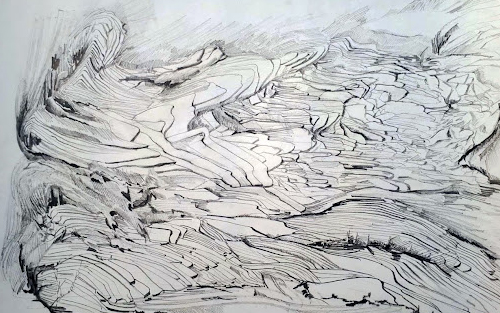Sem 02 | Form and Space Studies
Itinerants in a Nearby Galaxy
The Form and Space Studies module, conducted over six weeks across April and May, was an amalgamation of several smaller ambitions that we had for the semester. It collapsed what was meant to be a drawing module rooted in the idea of “sensoriums”, a series of lectures on visual culture and how it drives our image making processes. This was unintentional, dictated by larger complications and strange forces, but what this module allowed for was a delving into a serious form of investigation into the idea of space as experience.
The module began with students referring to a series of texts by Ursula LeGuin, from her book The Birthday of the World. Le Guin broadens the imagination of the world for us. She reorganises what we understand as the norms of gender, sexuality, and society and the reorganisation of space itself becomes inevitable. The excerpts from her book are spatio-sensorially charged:
“Then for half an hour nothing but the crisp whisper of the combs…”
“The joints in the bluish-dark arms and legs were like the joints in flower stems, translucent knobs.”
They begot drawings that did not simply invent bodies and spaces, but offered newer ways to see and inhabit the idea of the body and of space, by articulating the phenomenon of the experience that the text produced.
The drawings themselves were used towards the writing of a work, authored by the students themselves.
“It opened its exquisitely delicate wings and gently hugged me, its voice turned into a whisper, “As you feel like approaching me I too feel like being with you, I am fully with you’’.”
“Mr. Radley eats by himself, talks to himself, spends 80% of time reading books (it provides a much needed escape from harsh realities), and avoids other people.”
“Sweeeeeeee…….Sweeeeeeeee…….SHHHHHHHHH…..oooooooooo…...Shhhhhweeee…...Shhhhhh….weeeee…..Feeeeeee…...Shhhhhhooooo….Sheeeeeuuuuu…….wewewewewe…...Shweshweshwe….Shweshweshweeeeeee…...Shhhhhhhh…...Shooooooo…..Shweeeeeeeee…..Shhhhhhh…..Shoooooooo…..oooooo…..shweeeeee….Shhhhhhhh”
(read as a series of breaths and whistles)
“Vixen, curly hair, deep scars, reading empty eloquence.
Wet ground, excited boy with his football.
Stick, grandson enjoying gossip.
Skinny dog awaiting loving master.”
These are versatile, offering another dimension to the experience of the text, launching from the charge of the drawing itself, it’s forms are manifold - one inhabits the wind, speaks to many versions of the self, offers a prognosis of a fictional resident of the drawing, describes a chimerical beast that the drawing alludes to, becomes a scrawled, stream-of-consciousness diary entry; each one uses the text to further an imagination / inhabitation of space.
This atmospheric reading of the text excerpts is rooted in the understanding that we experience through our senses. Space is an envelope which we perceive through qualities of light and dark and scale and volume and form and density and which, expanded when looked at together in this module, became a vast geography - terrains and forms that coagulated and spoke to each other, landscapes that were at once about a sense of suffocation and a sense of being held as you moved by soft, furry fingers. Brought together by the sensorial explorations that they had been working with, the drawings and texts produced seven planets that had a particular conceptual charge and that collapsed geography, the body, planetary imaginations, and the space of the mind to produce a way of seeing that transcended the project and offered a way to expand the existing perimeters of looking at the world.
This was specifically achieved through dialogue - not just between students, but rather between these nascent productions. The conceptual charges allowed them to hold together a sense of the planet: The Planet of Obfuscations looked at blurring and softening and befogging as a method to read surfaces and edges and muddle the recognisable. The Planet of Fragments and Freezing held together spaces in nets and webs, scattered and splintered into pixels and shards, while The Planet of Instruments specifically linked the landscape inextricably to the body - one traversed contours on the new body, orbited it, built upon it as a prosthetic, extended it through apparatuses into space.
What these explorations produced is a performance made of mechanisms assembled to explore associations (built of scraps and offcuts of the material everyday - newspapers, fabric, string, and motley discarded objects), overlaid and braced by texts that allowed wider readings, and woven together through spoken colloquies between the microcosms that each reading of the texts put forth.
The resultant choreography is a film that takes you, the itinerant, across a galaxy where you are continually confronted and reacquainted with space, its determinants, and the logic of bodies and experience in these newly minted worlds.
Drawings as responses to text excerpts:



 Jinal Trivedi
Jinal Trivedi


Akanksha Satpute
![]() Krisha Dharaiya
Krisha Dharaiya
![]() Keerat Kaur Gill
Keerat Kaur Gill
![]() Maitri Shah
Maitri Shah
![]() Zahra Bagasrawala
Zahra Bagasrawala
![]() Khushboo Tejwani
Khushboo Tejwani




